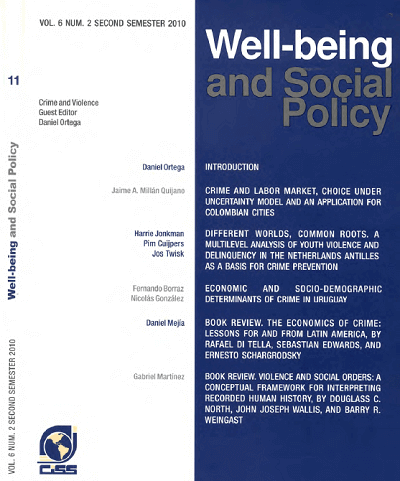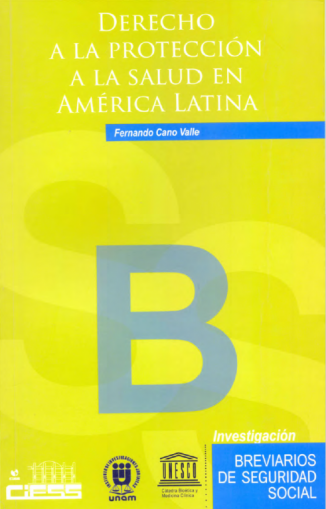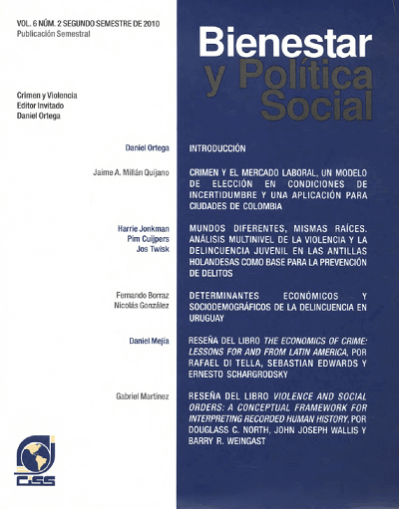|
Limitar tu búsqueda
[+–] Compilador o editor
[+–] Contributor
[+–] Creator
- Borraz, Fernando (2)
- Cano Valle, Fernando (1)
- Centro Interamericano de Estudios de Seguridad Social (2)
- Conferencia Interamericana de Seguridad Social (2)
- Cuijpers, Pim (2)
- Fernández Pastor, Miguel A. (1)
- Fort, Ricardo (2)
- Glave, Manuel (2)
- González, Nicolás (2)
- Jonkman, Harrie (2)
- Martínez Villalba, Luis José (1)
- Martínez, Gabriel (2)
- Mejía, Daniela (2)
- Millán Quijano, Jaime A. (2)
- Olaya, Ana C. (1)
- Ortega, Daniel (2)
- Premand, Patrick (4)
- Rosemberg, Cristina (2)
- Sadoulet, Elisabeth (2)
- Siegel, Paul B. (2)
- Twisk, Jos (2)
- Vakis, Renos (4)
- de Janvry, Alain (2)
- de la Fuente, Alejandro (4)
[+–] Editorial
[+–] Fecha
[+–] Formato
[+–] Idioma
[+–] Subject
[+–] Tipo de documento
[+–] Tipo de recurso
[+–] Clasificacion
|

|
|
Características demográficas y seguridad social en Colombia
El presente trabajo, presenta los pormenores del sistema general de seguridad social de Colombia, abarcando desde sus marcos legales y regulatorios, hasta los factores demográficos y sociales que han intervenido a lo largo del tiempo, en el diseño y puesta en práctica de un sistema que no es estático y, por ende, merece análisis permanente.
|

|
|
|
|

|
|
Reseña del libro The economics of crime: Lessons for and from Latin America, por Rafael Di Tella, Sebastian Edwards y Ernesto Schargrodsky
Este libro contribuye de forma importante al estudio de la delincuencia y la violencia en América Latina, así como al debate sobre lo que realmente funciona para reducir los índices delictivos (¿y a qué costo?). Como lo sugiere acertadamente su título, este libro recopila los estudios de economistas latinoamericanos sobre los factores determinantes y las consecuencias de la delincuencia, así como...
|

|
|
|
|

|
|
Trabajo y envejecimiento: teorías emergentes y perspectivas empíricas
Esta publicación publicación es el resultado de las actas del taller "Trabajando en la vejez — teorías emergentes y perspectivas emergentes sobre el envejecimiento y el trabajo", organizado por Cedefop, en septiembre
de 2008.
Contenido: Parte I. Los conceptos emergentes de desarrollo de carreras y los marcos para la capacitación de los trabajadores mayores. Perte II. Envejecimiento,...
|

|
|
|
|

|
|
Book review. Violence and social orders: a conceptual framework for interpreting recorded human history, by Douglas C. North, John Joseph Wallis, and Barry R. Weingast
Why societies differ in their level of violence? This is the question addressed by North, Wallis, and Weingast. To provide an answer they must develop a rich theory of how individuals and organizations that compose a human group voluntarily surrender their will to act violently in exchange for participating in a society with improved conditions for the creation and conservation of wealth.
|

|
|
|
|

|
|
Book review. The economics of crime: lessons for and from Latina America, by Rafael Di Tella, Sebastian Edwards, and Ernesto Schargrodsky
The Economics of Crime: Lessons for and from Latin America makes an important contribution to the study of crime and violence in Latin America and to the debate about what works for reducing crime (and at what cost?). As the title of the book correctly suggests, the book brings together contributions from Latin American economists on the determinants and consequences of crime, as well as...
|

|
|
|
|

|
|
Economic and socio-demographic determinants of crime in Uruguay
This study estimates a panel data model to analyze the economic and socio-demographic determinants of crime in Uruguay across the 19 Uruguayan departments in the period 1986-2006.
This research has two components: i) to present a systematic analysis of the Uruguayan crime data and socio-economic and demographic characteristics of the population, and ii) to evaluate the empirical significance...
|

|
|
|
|

|
|
Different worlds, common roots a multilevel analysis of youth violence and delinquency in the netherlands antilles as a basis for crime prevention
Most research on the prevalence, determinants, and variations of violence and delinquency among youngsters is conducted in Western societies. This multilevel study is set in the Netherlands Antilles (NA) and aims to build up prognostic multilevel models as a basis for targeted crime prevention in a non-western area. Data were collected from a sample of adolescente in the NA. Non-hierarchical and...
|

|
|
|
|

|
|
Crime and labor market, choice under uncertainty model and an application for colombian cities
Este trabajo ofrece un modelo para determinar la función de oferta del crimen con base en la teoría de la elección en condiciones de incertidumbre. Con base en el problema de un agente que maximiza su utilidad sujeto a las restricciones del mercado legal e ilegal, este estudio intenta explicar la oferta de la delincuencia como función de la distribución de los salarios y el equivalente cierto de...
|

|
|
|
|

|
|
Introduction (On the studies presented at the International Conference on "Delinquency and Violence in Latin America and the Caribbean")
Crime has become the leading concern for citizens of the region and has been pushed to the forefront of the international policy agenda; what is more, the combination of very few success stories and abundant failures in curbing crime and violence has underscored how thin our understanding is and the difficulty of designing and implementing an effective strategy at the local level. This issue...
|

|
|
|
|

|
|
Protecting vulnerable children from uninsured risks: adapting conditional cash transfer programs to provide broader safety nets
Conditional cash transfer (CCT) programs have proved to be effective in inducing chronic poor households to invest in the human capital of their children while helping reduce poverty. They have also protected child human capital from the shocks that affect these households. In this paper, we argue that many non-poor households exposed to uninsured shocks have to use children as risk coping...
|

|
|
|
|

|
|
Mainstreaming natural disaster risk management into social protection policies (and vice versa) in Latina America and the Caribbean
This paper presents and applies the social risk management (SRM) conceptual framework to examine links between disaster risk, hazards, vulnerability, risk management, and social protection (SP). The paper makes the case that it is important to mainstream social protection policies into the disaster risk management (DRM) agenda and, vice versa as a means to improve household and community...
|

|
|
|
|

|
|
Do shocks affect poverty persistance? Evidence using welfare trajectories from Nicaragua
Shocks are often primarily associated with downward mobility or short-term movements in and out of poverty. However, households at the bottom of the welfare distribution are likely to face the most constraints to access insurance mechanisms. In this paper, we consider whether shocks directly affect poverty persistence. In order to analyze the impact of shocks on households’ welfare path over time...
|

|
|
|
|

|
|
Effect of natural disasters on poverty transitions and consumption growth. Evidence for rural Peru
Natural hazards, an increasingly important phenomenon, have a direct impact at regional and household level. The growing incidence and persistence of natural events are strongly linked to increasing vulnerability of households and communities in developing countries. Previous socioeconomic vulnerabilities may exacerbate the impact of a specific event, making more difficult the process of...
|

|
|
|
|

|
|
Hurricane Mitch and consumption growth of nicaraguan agricultural households
There is little micro-evidence on the persistence of natural disasters' welfare impacts. This paper assesses the effect of Hurricane Mitch on consumption of Nicaraguan agricultura) households. Mitch occurred in October 1998. Pre-post data is obtained from a nationally representative panel collected in 1998 and 2001. An additional survey was fielded in 1999 for households from the panel affected...
|

|
|
|
|

|
|
Natural disasters and poverty in Latin America: welfare impacts and social protection solutions
The Inter-American Conference on Social Security (CISS) and the United Nations Development Programme (UNDP) Office in Mexico jointly organized the conference “Natural Disasters in Latin America: Welfare Impacts and Social Protection Solutions” held in Mexico City in January 2010. The main objectives of the conference were to improve the understanding of (i) how natural disasters affect...
|

|
|
|
|

|
|
Reseña del libro Violence and social orders: A conceptual framework for interpreting recorded human history, por Douglas C. North, John Joseph Wallis y Barry R. Weingast
¿Por qué difieren las sociedades en cuanto a niveles de violencia? Esta es la pregunta que abordan North, Wallis y Weingast. Para obtener una respuesta, deben desarrollar una elaborada teoría sobre la forma en la cual las personas y las organizaciones que componen un grupo de seres humanos, renuncian voluntariamente a actuar de manera violenta a cambio de participar en una sociedad que ofrezca...
|

|
|
|
|

|
|
Determinantes económicos y sociodemográficos de la delincuencia en Uruguay
Este estudio estima un modelo de datos de panel para analizar los determinantes económicos y sociodemográficos de la delincuencia en Uruguay, a través de los 19 departamentos uruguayos, en el período de 1986-2006.
Los objetivos de esta investigación son: i) presentar un análisis sistemático de los datos de delitos en Uruguay y de las características socioeconómicas y demográficas de la población...
|

|
|
|
|

|
|
Derecho a la protección a la salud en América Latina
En pleno siglo XXI, el derecho a la protección a la salud es inasequible para muchas personas en América. Por tal motivo, este análisis es un exhorto para destacar la importancia del derecho a la salud, así como una aportación para que sea conocido y ejercido por todos dentro de un contexto en el que el Estado la garantice y promueva.
|

|
|
|
|

|
|
Mundos diferentes, mismas raíces. Análisis multinivel de la violencia y delincuencia juvenil en las Antillas Holandesas como base para la prevención de delitos
La mayoría de los trabajos de investigación sobre la incidencia, los factores determinantes y las variaciones de la violencia y la delincuencia juvenil se llevan a cabo en sociedades occidentales. Este estudio multinivel se lleva a cabo en las Antillas Holandesas (AH) con objeto de construir modelos multinivel de diagnóstico que sirvan de base para la prevención dirigida de delitos en una zona no...
|

|
|
|
|

|
|
Crimen y mercado laboral, un modelo de elección en condiciones de incertidumbre y una aplicación para ciudades de Colombia
Este trabajo ofrece un modelo para determinar la función de oferta del crimen con base en la teoría de la elección en condiciones de incertidumbre. Con base en el problema de un agente que maximiza su utilidad sujeto a las restricciones del mercado legal e ilegal, este estudio intenta explicar la oferta de la delincuencia como función de la distribución de los salarios y el equivalente cierto de...
|

|
|
|
|
|